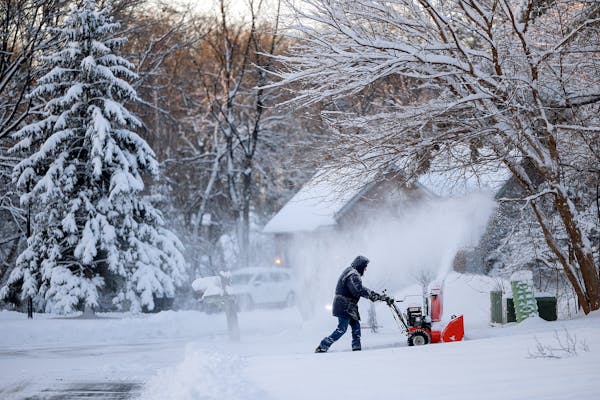It looked more like winter in the Twin Cities on Wednesday night and Thursday morning than it did in all of December and January, as the metro area saw the season's largest snowfall overnight. With temperatures expected to remain below freezing heading into the weekend, it appears winter has finally arrived.
Yet public works officials in Minneapolis and St. Paul decided Thursday against declaring snow emergencies. That's because conditions are ripe for the snow that's already on the ground to melt before it becomes too troublesome for drivers, officials in both cities said. And even though Thursday's forecast high is well below freezing, clear skies mean the sun's heating the pavement to about 45 degrees.
"Because of pavement temperatures and car traffic, all of the streets are either clear or on their way to getting clear," St. Paul Public Works Director Sean Kershaw said.
The lack of snow this season has also given public works crews in Minneapolis and St. Paul an opportunity to test new street clearing strategies in response to residents' evolving commuting routines and as climate change affects winter weather patterns in the Twin Cities.
The 6 to 7 inches that fell overnight in the Twin Cities ended the longest January thaw in recent history and made for a slower-than-usual commute as drivers navigated slush-covered roads. The State Patrol responded to several hundred spinouts and crashes from 7 a.m. Wednesday to 7 a.m. Thursday. Still, many metro-area residents were elated on social media as the snowfall marked the first real sign of winter after months of balmy temperatures and dismal accumulation.
Here are five things to know about how city leaders decide whether to declare snow emergencies — and how this winter is different from others.
Do Minneapolis and St. Paul residents have to move their cars?
Nope! Parking restrictions only take effect when officials declare a snow emergency. When they do, it kickstarts a sequence of events that keeps plows off residential streets for hours. Both cities require residents to move their vehicles by 9 p.m., which means that's the earliest that public works departments and their contractors can begin clearing those roads.
"The bottom line is that by not calling a snow emergency, we're getting into the residential streets a day earlier," Kershaw said.
Public works officials in both cities opted Thursday to have plow drivers clear the center lanes throughout the day, and salt the roads as needed.
Joe Paumen, Minneapolis' transportation, maintenance and repair director, said that deciding whether to declare a snow emergency is something of a balancing act.
"We always ask ourselves: Is it going to be more of a hassle to ask residents to move their cars, versus the benefit we can provide?" he said.
What about snowbanks trapping my vehicle in place?
There's no more snow in the forecast for the week, which means there's no risk of snowbanks building up in parking lanes and on sidewalks. Public works officials in St. Paul and Minneapolis say the lack of accumulation has also given them an opportunity to test new plowing routes and techniques since residents in both cities have changed the way they use urban roadways in recent years.
Snow emergency rules originated when urbanites used arterial roads and highways more than they do now. City leaders say they're looking to change which roads get priority as remote work has taken root and more people live closer to the downtown core in both cities.
"People want us to get into residential streets more quickly," Kershaw said. "Our traditional snow emergency model has needed updating for some time."
Where does climate change fit into the equation?
Temperatures well below freezing typically produce light and fluffy snowflakes. But those flakes have become wetter and heavier as winters have gradually warmed. The cities have also seen more rain in January and February, Kershaw said.
That means ice has become more prevalent on roads and sidewalks. Sometimes, it's because snow melts during the day as temperatures creep above freezing and then drop overnight.
"It's really a nightmare to clean," Kershaw said. "It just didn't snow like that 30 years ago. We're testing our strategies based on changing snow and climate, and changing expectations."
Paumen said officials in Minneapolis also keep abreast of changing patterns before adjusting their approach.
"Each snowstorm has been different," he said. "If we notice long-term trends in the weather, say if it's getting warmer, we're always looking to right-size our fleet and techniques to adapt to that.
"But we never make adjustments based on one year."
What should I keep in my car?
This week's snowfall was somewhat surprising; initial forecasts had the Twin Cities on track to get about 4 inches at most. With that in mind, it's never a bad idea to keep a winter kit in the car. Those caches should include a blanket, warm clothes, gloves, flashlight, nonperishable snacks and water.
Drivers should also check fluid levels, tire pressure and battery strength before heading out. As for navigating snowy roads, remember: Drive like Grandma is in the passenger seat wearing a new dress and holding a crockpot full of gravy.
Do I have to shovel my sidewalk?
Yes. Both cities require property owners to clear their sidewalks, even if a snow emergency isn't declared. If you need help choosing the right shovel, we've got a guide for that.
One dead, one injured in Cedar-Riverside neighborhood shooting

Black nonprofit sees investments in Duluth's Central Hillside as 'catalyst'

WWE releases Gable Steveson, closing a chapter for former Gophers sensation

Star Wars superfans celebrate May 4th with ritual movie marathons, blue milk, costumes and community

